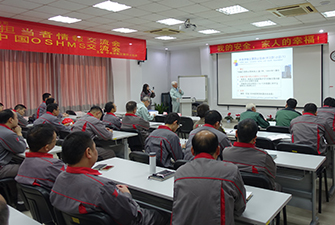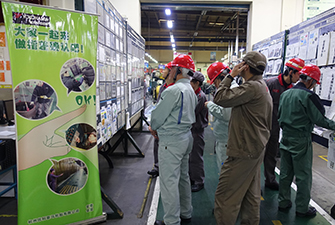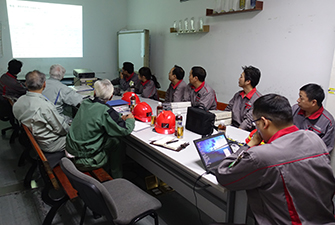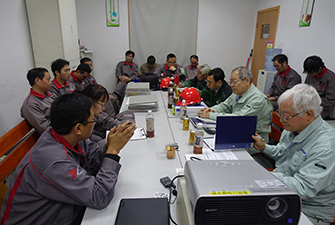KPI
-
Item
Lost-time injury frequency rate
(global, directly employed) -
FY 2016 results
(Consolidated) 0.60
Domestic 0.60
Overseas 0.61 -
FY 2017 results
(Consolidated) 0.50
Domestic 0.23
Overseas 0.64
-
Item
Scope of application of Occupational Health and Safety Program
-
FY 2016 results
―
-
FY 2017 results
100%
-
Item
Number of workers with a high risk of accident or illness
-
FY 2016 results
―
-
FY 2017 results
Zero
-
Item
Formal agreement with labor unions regarding occupational health and safety matters
-
FY 2016 results
―
-
FY 2017 results
Yes
(at those business locations where there is a labor union)
Responsible Departments
Each business location
* Activities are conducted by each business location, and the Central Committee of Safety and Health that the Safety and Health Management Department serves as a secretariat implements company-wide policy discussions and activities.
Stance and Target
Why is “Occupational Health and Safety” a critical issue to be addressed?
Explanation of the reason and background
We believe that for workers to be able to work in a secure and safe manner serves as the foundation for operations. As regards work-related accidents at the Yokohama Rubber Group in Japan and overseas, while the frequency of occurrence is low when compared with the average occurrence frequency for the production and manufacturing sector as a whole, it is not zero. Analysis of the causes of such accidents has revealed that many of them could have been prevented by countermeasures taken in advance. Because it is necessary to handle large-scale machinery at production plants due to the nature of our business, this leads to the possibility of major accidents from defects in equipment specifications and mishandling, and for this reason safety countermeasures are necessary. In addition, due to factors such as the fact that mental health issues account for an increasing percentage of long-term absentees, we need to respond fully to not only physical health, but mental health as well. For this reason, at the Yokohama Rubber Group we have selected occupational safety and health as a critical issue to be addressed.
Supporting System for Safety and Health Management
In Japan, we formed a “Safety and Health Sub-Committee” at each division and workplace and the “Office-Wide Safety and Health Committee (legally stipulated)” at each office, under our Central Committee of Safety and Health that is headed by the CSR Department Manager. The importance of safety and health activities is recognized by both Group companies and unions. Through interaction with the Japan Rubber Manufactures Association and Japan Rubber Workers Union Confederation to share safety information with other companies and other union confederation members, we are also trying to facilitate collaborative action by labor and management. We also share our activities with our subcontractors by having them join their respective committees. As for our various overseas offices, they have their own supporting system in place according to the prevailing law under their country’s governance. The Safety and Health Management Department manages activities relating to safety and health both in Japan and overseas.
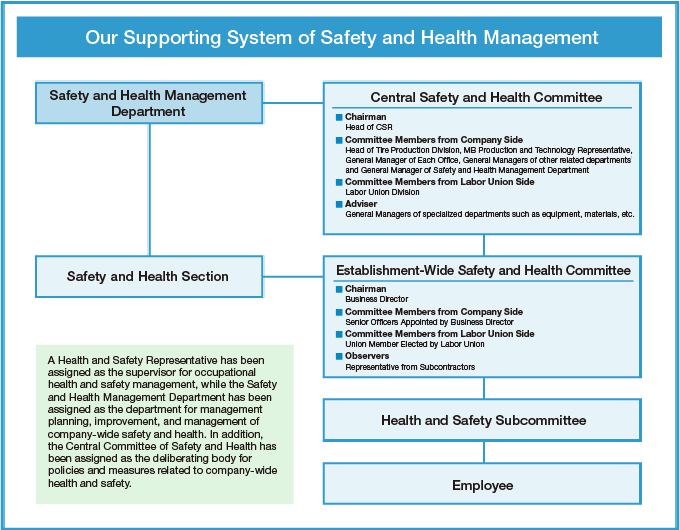
Vision (attainment goal) / target
- We will promote the creation of a safe and comfortable working environment and good health.
- We will establish a safety culture aiming for zero risks, and aim for zero work-related accidents.
Measures for vision achievement
We will implement the following seven measures to create workplaces that enable employees to work in a safe and healthy manner.
- Strengthening safety measures for equipment and work
Implementing risk assessments for all equipment and work, creating facilities so that sources of danger don’t reach the bodies of people and cannot be reached, and implementing safety measures taking into account the line of vision of workers and the motion lines of people. - Developing safety-conscious human resources
Conducting One-on-One education, to develop safe workers. Reinforcement of Stop-Call-Wait procedure and countermeasures in response to risk causes. Implementation of KYT (Kiken Yochi Training / hazard prediction training), sampling and improvement of near-miss incidents, and hazard demonstration training in order to improve sensitivity towards risks. - Development of standard work manuals
Identifying unsafe places and unsafe behaviors and reviewing standard work through open work observation. - Promoting both physical and mental health
Strengthening mental health countermeasures (management of working hours, face-to-face guidance and work improvement suggestions for employees working long hours, education for improving communication skills through attentive listening training classes, and conducting stress checks). - Improvements in workplaces
Chemical substances risk assessment, improvements in equipment development and working methods, and thoroughly enforcing the 5Ss (seiri [tidiness], seiton [being organized], seisou [cleanliness], seiketsu [hygiene], and shitsuke [discipline]). - Prevention of traffic accidents
Conducting accident prevention activities and identifying risk points on commuting routes in order to achieve the target of zero accidents resulting in injury or death. - Establishment of a safety and health platform
Continuation and spiraling up of management systems (JISHA method qualified OSHMS, OHSAS18001, and ISO 45001), development of job grade-specific training system, enhancement of check function through safety patrols, safety diagnosis, and diagnosis follow-up
Review of FY 2017 Activities
The following activities were conducted for the measures implemented in FY 2017.
1. Strengthening of facility measures
Risk assessment for all facilities and work is implemented in a planned and ongoing manner, and safety measures are being implemented for facilities. In particular, we focused on implementing safety measures in relation to maintaining a distance from risk sources; to this end, we have implemented a worldwide facilities inspection program.
-
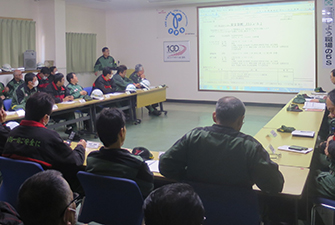
-
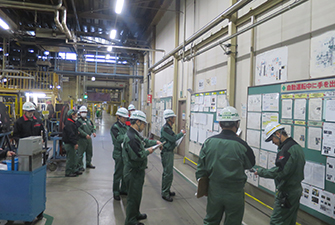
Safety diagnostics
2. Developing safety-conscious human resources
We are trying to train our workers to have good safety awareness, so that they can foresee risks in any potential situation. We are conducting KYT (Kiken Yochi Training / hazard prediction training), which is to be done by every worker every day, along with sampling and improvement for near-miss incidents, which constitute self-directed activities that we encourage everyone to participate in. We have also conducted hazard demonstration training sessions at our Taikan Dojo (training through actual experience for accident prevention). Also, we have facilitated safety awareness-raising by focusing on communication, for example by having supervisors interact with workers one-to-one to help them understand the meaning of each operation until the worker develops the autonomy needed to conduct safe operations on their own.
In addition, as people who work with us, partner employees also participate in activities to prevent the occurrence of disasters in an effort to improve safety levels.
-
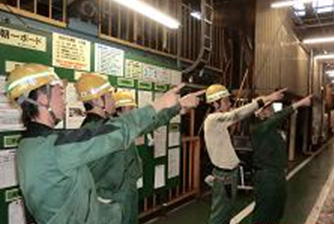
KYT
-
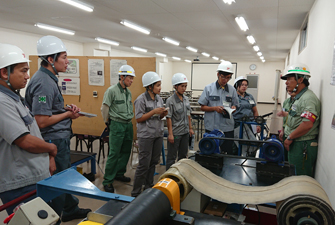
Hands-on safety drills with overseas trainees
(V belt catching hands-on experience equipment)
-
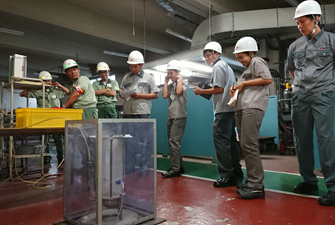
Hands-on safety drills with overseas trainees
(Dust explosion hands-on experience training equipment) -
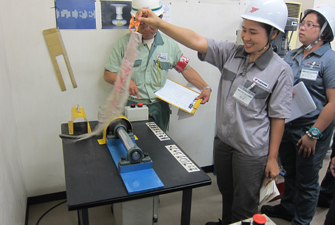
Hands-on safety drills with overseas trainees
(Shaft catching hands-on experience equipment)
3.Development of standard work manuals
We conduct open work observation in a planned and ongoing manner, and identify unsafe places and unsafe behaviors and review standard work manuals.
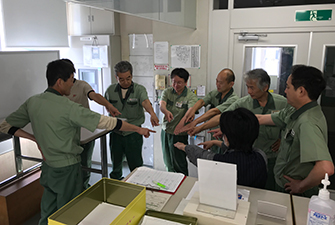
Singing the Safety Chant together before beginning work.
4.Promoting both physical and mental health
Our efforts in mental health include management of working hours through a clocking in and clocking out system, face-to-face guidance and work improvement suggestions for employees working long hours, education for improving communication skills through attentive listening training classes, etc. In addition, stress checks were commenced from fiscal 2016. These checks are mainly for the purpose of assessing the level of stress of employees and encouraging employees to notice their own stress levels in order to lead to improvements in the workplace and encourage the creation of ideal working environments, which will prevent mental health issues among employees (primary prevention).
For the reinstatement of long-term absentees who have been absent due to mental health reasons, we hold interviews with the employee involved, and confirm the situation with family physicians, industrial physicians, public health nurses, and the workplace in order to discuss matters such as the means of reinstatement, timing, and work limitations in order to achieve a well-planned reinstatement. Reinstatement has been achieved at the Head Office and Hiratsuka in cooperation with the Jikei University Hospital and three industrial mental health physicians, which is still a relatively rare situation.
Furthermore, after reinstatement, regular three-party interviews are held between employees, industrial physicians, and workplace representatives in order to gradually loosen work limitations and provide follow-up until all restrictions have been fully released.
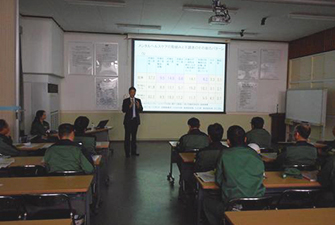
Stress check study session given by the Japan Industrial Safety and Health Association (Mie Plant)
5.Improvements in workplaces
We have improved equipment and promoted the improvement, maintenance, and management of working methods aimed at using working environment measurements in order to maintain a pleasant workplace. In addition, based on the 5S (seiri, seiton, seisou, seiketsu, and shitsuke, or sorting, straightening, systematic cleaning, standardizing, and sustaining) methodology, we promote manufacturing where the things you need are available in a location that is not unsafe when you need them.
6.Preventing traffic accidents
Each business locations conducts awareness raising activities while cooperating with the holding of traffic safety seminars with local police stations and traffic safety related organizations. In addition, traffic etiquette classes are provided by traffic safety expert Mr. Yahashi for students in the fourth grade of elementary schools located near our business locations to contribute to the prevention of local traffic accidents. Education was provided in 58 lessons for 34 classes in 14 schools during 2017. We will continue to expand these efforts in the future.
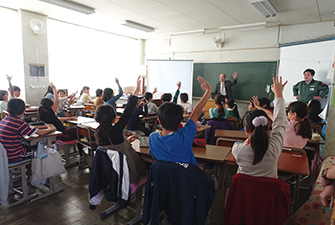
Road safety etiquette class for elementary school fourth graders
7.Establishment of a safety and health platform
We have acquired Occupational Safety and Health Management System (JISHA/OSHMS) certification at 17 domestic and overseas business locations; during fiscal 2017, we acquired this certification at one additional business location and renewed the certification at 5 business locations (the certification process is ongoing at other business locations).
In addition, OSHMS level-up audits by Japan Industrial Safety and Health Association (JISHA) based on JISHA standards that started in Japan in April 2015 were expanded to 1 additional business locations in 2017, and certification was successfully renewed. We will continue to improve management systems and implement the PDCA (plan, do, check, act) cycle as we work to enhance our safety and health infrastructure.
The frequency of occupational accidents was 0.23. We will be working to achieve the target of zero accidents and also to realize zero risks.
Frequency of Occupational Accidents (Lost-time injury frequency rate)
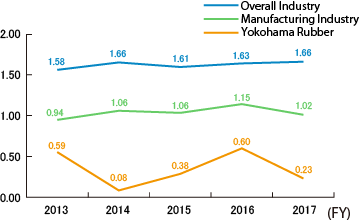
Explanation of the numbers
※ * Lost-time injury frequency rate = (number of work-related injuries / total working hours) x 1,000,000 hours
* All data are annual aggregated values (January to December)
* Figures for all production industry (excluding general contracting) and manufacturing industry are based on the Survey on Industrial Accidents statistical table released by the Ministry of Health, Labor and Welfare
| FY 2015 | FY 2016 | FY 2017 | |
|---|---|---|---|
| Lost-time injury frequency rate | 0.38 | 0.60 | 0.23 |
| YRC frequency rate | 1.30 | 1.03 | 0.75 |
The Group conducts strict management based on Yokohama Rubber’s unique frequency rates (all frequency rates).
Yokohama Rubber’s unique management standards (YRC frequency rate): The YRC frequency rate covers all accidents that occur at the company, and it is calculated including dispatched and contracted workers based on a coefficient of 1.0 for major or lost-time injury resulting in leave (one day or more), 0.3 for minor injury not resulting in leave, and 0.1 for light injuries.
This is because we believe that it is necessary to enact countermeasures and work to prevent recurrence of not only injuries resulting in leave but all injuries, including injuries not resulting in leave and light injuries, involving everyone working at Yokohama Rubber, in order to achieve the goal of zero accidents.
Overview of Initiatives
On Wednesday November 22, 2017, the “2017 Japanese-owned Enterprises Occupational Health and Safety Managers Information Exchange Meeting – Let’s Get Together to Think About How to Reduce Occupational Accidents and Invigorate Health and Safety Activities” meeting, organized by the Japan Industrial Safety & Health Association (JISHA), was held at the Hangzhou Yokohama Tire Co., Ltd. (CHZY) factory in Hangzhou, China.
The main participants in the meeting were occupational health and safety managers etc. at Japanese-owned enterprises operating in China. Held with the aim of helping to reduce the incidence of occupational accidents and revitalize health and safety activities, the meeting provided an opportunity for sharing information about “zero occupational accidents” initiatives, the adoption and effectiveness of occupational health and safety management systems, and the health and safety issues affecting individual workplaces, etc. The meeting was attended by representatives of the China Academy of Safety Science and Technology (CASST), a research institution affiliated with the Chinese government. The meeting benefited from funding support from Japan’s Ministry of Health, Labour and Welfare (MHLW), and the Yokohama Rubber Co., Ltd. also assisted with the organizing of the event.
The number of participants from various different companies exceeded the 40-person capacity of the venue, reflecting the high level of concern for occupational health and safety activities among Japanese-owned enterprises.
The activities during this combined study session and exchange meeting included the following: (1) A representative of the China Academy of Safety Science and Technology (CASST), which is affiliated with the Chinese government, gave a talk on the theory and practice of hazard prevention activities. (2) The director of JISHA’s JISHA-ISO Management System Audit and Certification Center reported on the status of the establishment of the ISO 45001 standard for occupational health and safety management systems, and on the Japanese management standard that is being recommended by the MHLW and promoted by Japan’s Ministry of Economy, Trade and Industry (METI). (3) Participants were given a presentation on the occupational health and safety activities implemented at Hangzhou Yokohama Tire Co., Ltd. (CHZY), and were also given a tour of the plant to see how the activities are implemented in practice. (4) The participants engaged in small group discussions (exchanging ideas and views regarding the issues affecting occupational health and safety, including the causes of occupational accidents in the workplace, and the current status of implementation of relevant measures, etc.).
Participants felt that the meeting had been a very meaningful and worthwhile experience, with comments such as: “It was great having the opportunity to learn about the implementation status of health and safety activities, and about the situation and problems experienced at other companies, etc.”
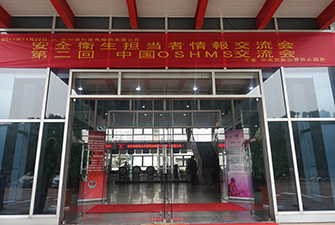
The entrance to the venue
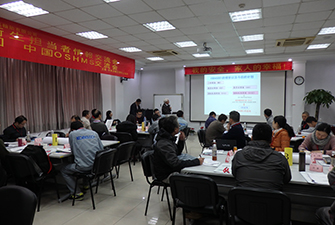
The meeting venue
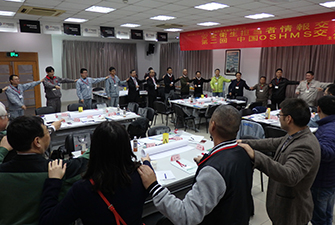
The meeting venue
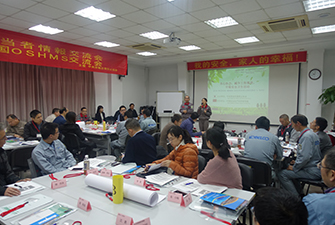
The meeting venue
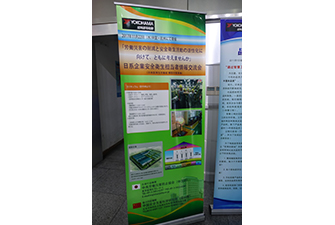
The entrance to the venue
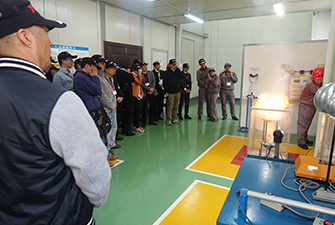
Factory tour to help participants learn about experiential training
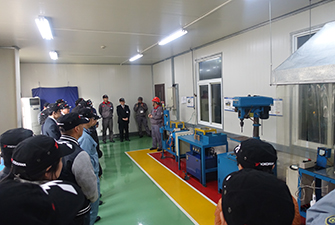
Factory tour to help participants learn about experiential training
Issues and Future Improvement Measures
We are implementing various measures aimed at creating a safe and employee-friendly workplace environment, and at safeguarding employees’ health; however, the current situation is that we have yet to realize our goal of reducing the number of accidents to zero.
Besides proceeding with facilities-related measures that focus on maintaining distance from sources of danger, we are also working to cultivate employees who know how to act safely.

